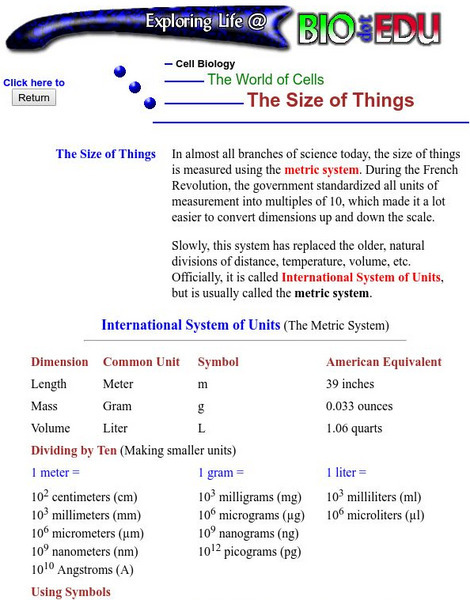Hi, what do you want to do?
Curated OER
Investigating Leaves Through Printmaking
Students create leaf rubbings as they study the parts of a leaf. They describe the leaves and chart their observations.
Curated OER
Eency Weency Spider
Students use the poem "Eency Weency Spider" to understand up and down. Students say the poem and act out the motions. Students make their own spider puppet and move their spider with the poem.
Curated OER
Reading Signs
In this signs worksheet, 2nd graders look at a castle picture, find the signs in the picture that have the same shape and size and color each pair of signs the same color.
Curated OER
Finding the Smallest Apple
In this finding the smallest apple worksheet, students look at the pictures in four boxes, then color the smallest apple in each one.
Curated OER
Same Size
Learning how identify similar shapes is an important skill for students to acquire. For this shapes and sizes worksheet, students look at the colorful shapes in each of 3 rows and circle the shape in each row that is the same size as the...
Curated OER
Sizes Worksheet: Longer
Learning how identify similar shapes is an important skill for learners to acquire. In this sizes worksheet, students name each shape on each row and then draw the same shape again in the space to the right. Learners make their shape...
Curated OER
Size Worksheet: Tall and Short
In this size/shape worksheet, students look at shapes on a 4 section grid. Students determine which shape is tall, which is short.
Curated OER
Sizes Worksheet: Shortest
In this sizes worksheet, students study three rows of trees and determine which tree in each row is the shortest. Students circle the shortest tree in each row.
Curated OER
Sizes Worksheet: Same Size
In this same size worksheet, students look at the three pictures of sports balls on the left in each of three rows. Students determine which picture on each row is the same size as the first picture and then circle their answers.
Curated OER
Sizes Worksheet: Tall and Short
In this shapes learning exercise, students look at the eight shapes on the learning exercise and draw a line from the tall shape to the short shape to match up the shapes. Students color each shape a different color.
Curated OER
Big and Small
In this shapes worksheet, students look at four different shapes and then draw a line from the small shape on the left to the big shape on the right that matches.
Curated OER
Sizes: Shorter
In this size worksheet, students will focus on shapes that are shorter. Students will study 3 shapes and then draw the same shapes, but showing that they are shorter than those already pictured.
Curated OER
Size: Bigger
In this size worksheet, students will focus on shapes that are bigger. Students will study 3 shapes and then draw the same shapes, but showing that they are bigger than those already pictured and using the corresponding colors on what...
Curated OER
What's The Matter
Students identify and describe the different stages of matter. In groups, the use lego pieces to represent the moving parts of matter. They use the internet to research the meanings of nano, micro and macro sizes. They also use the...
Curated OER
Multicultural Literature Lesson Plan The Lotus Seed by Sherry Garland
Sixth graders begin reading "The Lotus Seed" before determining a plant that is a representative of their country or region. They illustrate the plant and write sentences about it and locate the region on a map. Finally, they make a...
Curated OER
Big Bug, Little Bug
In this comparison worksheet, students cut out 8 black line pictures of big and little bugs. They place the pictures in the chart which is labeled with big, and little.
Curated OER
Sizes, Sizes, Choosing the Largest and Smallest
In this size comparison worksheet, students examine 4 rows of black and white clip art pictures. They draw an X on the largest picture and a circle around the smallest picture.
Curated OER
Sizes Worksheet- Shortest
In this size comparison worksheet, students look at 4 ovals and 4 rectangles in two columns. They decide which shape is the shortest in each column and circle it.
Curated OER
Who Is Average?
High schoolers investigate the average sizes for males and females. They discuss averages in relation to the amount of material needed to make underwear. In teams, they create a data table of small, medium, and large sizes and calculate...
Curated OER
Determine Soil Particle Size
Students examine various soil samples in groups. Using the samples, they identify the characteristics of them and calculate percolation and infiltration rates. They use this information to discover why some species can survive in one...
Curated OER
From Big to Little, From Little to Big
Students discuss how different objects are different sizes. They work together to brainstorm ideas of objects that do not stay big or little all of the time. They choose one of their ideas to illustrate and share with the class.
City University of New York
Cuny: The Size of Things
A review of the metric system and where cells fit into the scale of sizes.


























